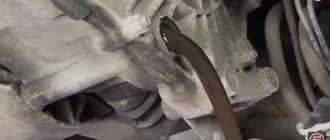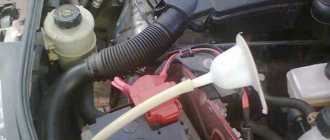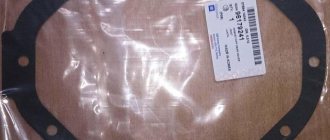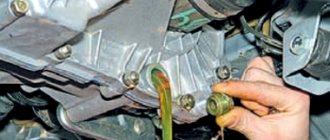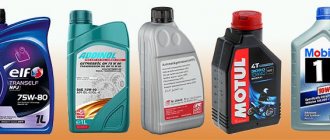Before changing the oil in an automatic transmission, everyone at least once has to ask the question: “How much of this oil is actually needed?” After all, completely different boxes are installed on different cars and different schemes are used.
And okay, the first problem is to buy more oil to replace than necessary. As a result, such a miscalculation will simply result in extra wasted money and space taken up by eggplants.
It’s probably worse that you don’t buy more oil. If you realize during the replacement process that you don’t have enough transmission fluid, you will have to run/go to the auto shop one more time (how can you go if the car cannot be operated without oil?), or you will have to order and wait for the missing portion of oil (again, having left without wheels).
It’s even worse to fill in the fluid as much as there was, not fill it up to the level, and then drive like that. The box will behave incorrectly, or even stop completely very soon due to lack of pressure and running dry.
To prevent such troubles from happening to you, learn the equipment. In this case, things are quite simple, and we will help you figure them out.
How often to fill the gearbox with oil
The lubricant protects the gearbox from wear.
The frequency of oil changes depends on which gearbox is installed in the vehicle. In addition, the load on the unit plays a big role.
The manual gearbox has a simple design. In it, torque is transmitted to the drive wheels through shafts and gears, which are constantly in contact with each other. If your car has a manual transmission, you need to change the oil at least every 150 thousand kilometers. Cargo transportation, movement over rough terrain, adverse weather conditions - such loads reduce the frequency of oil changes by half.
Automatic transmissions differ in their operating principles, but they are all uniquely more complex than mechanics. The oil in them is the working fluid. It not only lubricates the transmission parts, but also removes heat from the torque converter. For stable operation of the automatic transmission, it is recommended to change the oil in it every 30–50 thousand kilometers.
A CVT is a continuously variable transmission in which torque is transmitted from the engine to the transmission through 2 pulleys. Such a box is very sensitive to slipping, frequent acceleration and deceleration. Aggressive driving wears out pulleys and transmission belts, causing particles from moving parts to contaminate the oil. Therefore, experienced auto repairmen recommend changing the lubricant in CVTs after about 40 thousand kilometers.
A robotic gearbox with two clutches is essentially two manual gearboxes with an electronic control unit that automatically changes gears. In this case, one manual transmission is responsible for even speeds, the second for odd ones. In a manual transmission, many complex parts experience load: clutch discs, servo and hydraulic drives, valve body, etc. In order for a complex unit to serve without interruption, it is recommended to change the oil in it every 50-60 thousand kilometers.
These indicators are approximate - in any case, you should follow the recommendations established by the car manufacturer.
How to determine when it's time to change the oil:
- By mileage
- After purchasing a used car, unless there is reliable evidence of a recent replacement.
- There are jerks and delays when shifting gears
What to pay attention to when changing gearbox oil in order to prevent possible serious damage to the unit:
- used oil smells like burning;
- the amount of work is less than required;
- the used lubricating fluid has become very dark;
- Metal particles were found in the used oil.
But what happens if you ignore the recommendations for changing the gearbox oil? Over time, the lubricating fluid loses its original properties, becomes dirty, foams and thickens. Because of this, the gearbox components stop working as expected, which leads to gear shifting, increased friction losses and an increase in operating temperature. As a result, the gearbox quickly wears out, which can lead to extremely expensive repairs or complete replacement of the unit.
Frequency of replacing transmission fluid in the "Seven"
The schedule for changing transmission oil depends not only on the mileage of the car - for the VAZ 2107 it is 70 thousand kilometers - but also on the operating conditions of the car.
Let us highlight those factors that negatively affect the service life of the oil and reduce the replacement time to 50-60 thousand kilometers:
- Frequent off-road driving, dusty and polluted areas
- High driving speed
- Engine overheating when operating at high speeds
- Climate change, sudden temperature changes
As already written above, the VAZ 2107 was created on the basis of the Italian model of the 1960s Fiat 124. Therefore, it is quite natural that the “Seven” is not suitable for modern operating conditions or too active driving. It is adapted to bad roads in terms of comfort, but not endurance.
How much oil is poured into the gearbox
Since the oil in a manual gearbox primarily performs lubricating functions, its consumption is relatively low. As a rule, 1.6 liters of oil must be added to a 5-speed gearbox, and 1.3 liters to a 4-speed gearbox.
In an automatic transmission, ATF oil is consumed by several key components at once. The torque converter takes about 2 liters, the pump and gears - about 4 liters, the oil line and radiator - about another 2 liters. Consequently, the total oil consumption on an automatic transmission is approximately 8 liters for a passenger car. SUVs require even more oil - about 9-10 liters. If the car is equipped with a variator - an automatic transmission without a torque converter, the oil consumption will be 1-2 liters less. Depending on the number of stages, it is recommended to fill the robotic box with 1.9 to 2.4 liters of oil.
Technical regulations on the amount of transmission substance
Transmission fluid is monitored every 10 thousand km, i.e. during the next maintenance. Before checking the amount of substance, you need to let the car sit for a while. During this period, the transmission fluid will have time to flow down the walls of the box. If the fluid level reaches the edge of the lower edge of the filler hole, then its volume is quite sufficient, and the oil is not replaced or topped up.
How much transmission oil will be needed when completely replacing it directly depends on the type of gearbox. According to the technical instructions, the following volume of liquid is established:
- for 4-mortar – 1.35 l;
- for a 5-mortar – 1.6 l.
Experienced drivers advise filling the 5-mortar with lubricant slightly above the set level - “as much as it will fit.” To do this, lift the car from the driver's door with a jack. Then add 250–300 g of liquid. This will ensure reliable lubrication of the 5th gear gear. There is no need to be especially afraid of increased pressure on the seals, since excess pressure is released through the breather.
What kind of oil should I put in the box?
Gearbox oils, like motor oils, are divided based on several groups: more about this in the article “What makes up the cost of motor oil.”
- Mineral oils are produced by distilling petroleum. At the same time, the molecular structure of such a lubricant does not change.
- Synthetic oils - in their production various additives are used that increase the performance properties of the lubricating fluid.
Synthetic oil tends to be thinner at low temperatures and more stable to environmental influences. For example, if mineral oil lubricates all the parts of the box in a few minutes from the moment you start work, synthetics reduces this time to 30–40 seconds. This is especially true for cold starts in winter.
How to pour oil into a gearbox
It is necessary to drain the oil from the gearbox into a special pan.
Changing the oil in a manual transmission is a procedure that can be completed without the help of a mechanic. An important point is that before changing the oil in the box, the lubricating fluid currently used must be warmed up. This will make it easier to drain the oil. To warm up the oil, just drive the car for 5–10 minutes. Next, you can start changing the oil:
- Drive the car onto the overpass.
- Put the car on the handbrake.
- Remove the protective cover from the gearbox and the cap from the breather (pressure equalization valve).
- Clean the breather.
- Unscrew the drain plug.
- Drain the used oil - this usually takes 10-15 minutes.
- Tighten the plug.
- Fill in the required amount of oil using a special syringe.
- Screw on the breather cap.
- Install gearbox protection.
Changing the oil in automatic transmissions and variators is carried out using special equipment at a specialized service station.
Checking the oil level and condition
For preventative purposes, it would be a good idea to regularly check the volume and condition of the lubricant in the gearbox. Experts recommend doing this every 10 thousand kilometers of the car.
You can determine the oil level in the VAZ-2107 gearbox using a screwdriver or other object like a dipstick. You will also need a clean rag and a wire brush.
Place the car on the inspection hole, use a brush and a rag to clean the surface of the box near the oil filler hole. Wipe and unscrew the plug. Place a screwdriver into the hole. The oil level should reach the bottom edge of the filler hole.
Evaluate the appearance of the lubricant. If it is dark and cloudy, or contains sediment, then it will need to be completely replaced - even if the deadline according to the regulations has not yet arrived.
Under what conditions is replacement made?
It is recommended to simultaneously replace lubricants in two automotive components:
- checkpoint;
- gearbox (rear axle).
The operating regulations require such replacements every 35 thousand km or after 3 years of use of the VAZ 2107 - whichever comes first. Some advice on replacing the fluid in the gearbox applies to cases of purchasing a used VAZ 2107. Despite the assurances of former owners that the fluid was replaced recently, it is better to play it safe and change the oil in the gearbox.
In addition to the above cases, replacement of the transmission substance is necessary when:
- the fluid level drops below the recommended level;
- the presence of silvery dust in the transmission substance;
- change in the color of the fluid (black color or a brown-coffee tint indicates the destruction of additives or water entering the gearbox).
We can safely say: the quality of the transmission oil determines the condition of the gearbox or even the entire car. Therefore, it is quite acceptable to change the fluid more often. For example, after 20–25 thousand. km run.
Universal liquid
Such ATFs meet the tolerances of several manufacturers at once. They are used by owners of different models. Among the advantages of non-original liquids are:
- cheapness;
- wide choice of manufacturers;
- The quality most often corresponds to the original oils.
Disadvantages of universal transmission fluids:
- it is necessary to know the tolerances;
- there is a possible risk of transmission breakdown if the wrong fluid is selected;
- removing the car from warranty.
Selecting a universal ATF analogue is much easier for European-made cars. This is due to European antitrust laws. Buying fluid for a Japanese car is more difficult.
There are many resources for selecting oil by VIN - vehicle identification number.
About various automatic transmissions
To begin with, I want to note that today we will talk only about two types of automatic transmissions - a CVT and a classic torque converter automatic. There will be no robot here! Why? YES, everything is just a robotic box, similar in structure to the mechanics, it actually contains little of the same amount - to be precise, about 3 - 4 liters, and it is made using a different technology.
The variator and automatic transmission have their own oil, or rather it is commonly called ATF fluid , it is much thinner, in fact, that is why it is called “fluid”. As a rule, it is used much more in a building. But more on that below.
Table of volumes of several brands (how much to pour for a complete replacement)
| BRAND | Amount of oil in automatic transmission (in liters, for complete replacement) |
| Hyundai Accent (1994 - 2000) | 4,5 — 5 |
| Chevrolet Cruze | 7,6 |
| Chevrolet AVEO (T300) | 7,6 |
| FORD FOCUS 2 | 5 |
| Hyundai Solaris | 6,8 — 7 |
| KIA RIO | 6,8 — 7 |
| MAZDA 3 | 7,5 — 8 |
| Nissan Almera Classic | 7,8 — 8 |
| Opel ASTRA H-J | 7 — 8 |
This is where I end, I think the article was useful to you. Read our AUTOBLOG.
Similar news
- Why do they install a CVT instead of an automatic? Details + video
- I engaged reverse gear at speed - WHAT WILL HAPPEN? Let's take the car apart...
- Do I need to change the filter in the automatic transmission? When changing the oil? A few words about Sh...
What will be needed for replacement and what materials to choose
To replace the transmission substance in the VAZ 2107 box you will need:
- oil blower (lever grease gun, syringe with elastic tube, rubber hose with watering can);
- set of tools (key 17, hexagon 12);
- containers for used transmission fluid;
- dry rags;
- transmission oil.
Particular attention should be paid to which oil is best suited for the seven-speed gearbox. The answer options vary significantly in the quality level of the product and its cost. The recommendations are full of names of well-known brands for the production of lubricants. Which one to choose is not easy to decide. It is important that the selected transmission fluid is indicated by markings within the range 75W90 - 80W95. The lubricant group should be designated GL-4 or GL-5.
Mitsubishi ASX 1.8 (Mitsubishi ASX) do-it-yourself oil change in the variator. Photo and video instructions
A Mitsubishi ASX car came to us for service, with a 1.8 liter engine, manufactured in 2013, front-wheel drive, mileage 202 thousand km. It is necessary to change the oil in the variator, in addition to this, we will replace the heat exchanger filter and the variator itself. After looking at this photo and video instructions, you can repeat everything yourself in a garage.
The process of changing the oil in a Mitsubishi ASX variator
The owner’s variator began to behave a little problematically; it has a “tightening” when engaging gears. If you put it in gear and give it gas, it hits. The first oil change was performed at 130 thousand km. mileage For today's replacement, 8.8 liters of new CVT Fluid J4 oil were purchased, order number MZ320185.
Let's get to work, lift the car, dismantle the left front wheel. We take out the clips and remove the wheel boot. We place the waste oil container down and unscrew the drain plug using the 19mm head:
Our glass is about 4 liters. Then screw the plug back into place. Take a funnel with a spout, insert it into the hole for the dipstick and fill in 3 liters of new oil:
You can start the engine without pulling out the funnel. With the car stationary, hold the brake pedal, turn on each gear alternately and hold it for 10-15 seconds. We turn off the engine. We climb under the car again and unscrew the drain plug, draining the filled oil. After the oil has drained, we begin to unscrew the pan, we do this using a 10mm socket.
Use a 10mm head to unscrew the variator filter:
While the last drops are draining from the variator, we move on to the heat exchanger. Using a 10mm socket, unscrew the 4 bolts of its fastenings:
You may need a flexible extension to get to the top two bolts. We move the heat exchanger to the side, using long clamps we take out its filter:
When removing the filter, pay attention to its rubber band; if it is not removed along with the filter element, it means it remains in the car, be sure to remove it. The new filter immediately comes with a new o-ring. We install a new heat exchanger filter, its order number is 2824A006
It is very easy to install by hand:
We install a new heat exchanger filter, the original one, its order number is 2824A006. It is very easy to install by hand:
The new filter immediately comes with a new o-ring. We install a new heat exchanger filter, the original one, its order number is 2824A006. It is very easy to install by hand:
We move on to replacing the heat exchanger gasket, we have a new one, original from Mitsubishi, order number 2920A096. We dismantle the old one using a flat screwdriver:
Take carburetor cleaner and wash the groove, then wipe it dry. Install a new rubber ring into the groove. Carefully place the heat exchanger in place and tighten the bolts.
We return to the variator, install a new filter on it, we have it from Asakashi reviews, order number JT406K.
The filter comes with a new rubber-cork pan gasket, but we will not install it; we pre-ordered the original one, its purchase number is 2705A096.
If you have a torque wrench, then you need to tighten the fastening bolts with a force of 9 Hm.
Before installing a new pan gasket, wash off any remaining oil using carburetor cleaner, then wipe it dry with a clean cloth. We also thoroughly clean the tray and magnets.
We put the gasket on the pallet and attach it. The gasket and tray have guides on the sides. We tighten the pan bolts with a force of 9 Hm.
The original gasket is profiled, it holds perfectly, does not sweat, there is no need to coat it with sealant.
We lower the car and safely fill in 4 liters of new oil for the variator. We start the engine, make sure there are no leaks underneath, warm it up to operating temperature and set the level. In our case, we had to add even more liter.
TOYOTA CARINA 1992-1996
| Engine (motor oil) Engine | Working volume (l) | Modification | Without filter replacement (l) | With filter replacement (l) | SAE | API |
| 5A-FE | 1,5 | ~02.1994 | 3,1 | 3,3 | ||
| 02.1994~ | 2,8 | 3,0 | ||||
| 4A-FE | 1,6 | ~02.1994 | 3,1 | 3,3 | 10W- 30 | |
| 02.1994~ | 2,8 | 3,0 | S.G. | |||
| 4S-FE | 1,8 | 3,7 | 3,9 | |||
| 7A-FE | 3,5 | 3,7 | ||||
| 3S-FE | 2,0 | 3,7 | 3,9 | |||
| 2C | 2,0 | ~02.1994 | 4,8 | 5,3 | 10W- | CD |
| 02.1994~ | 3,6 | 4,3 | 30 |
| Engine (cooling system) Engine | Working volume (l) | Modification | Filling capacity (l) | Ethylene glycol content (l) | ||
| 30% | 50% | |||||
| 5A-FE | 1,5 | M/T | 5,4 | |||
| A/T | 5,3 | 1,6 | 2,7 | |||
| 4A-FE | 1,6 | M/T | 5,4 | |||
| A/T | 5,3 | |||||
| ~02.1994 | 6,0 | 1,8 | 3,0 | |||
| 4S-FE | 02.1994~ | M/T | 6,6 | 2,0 | 3,3 | |
| 1,8 | A/T | 7,0 | 2,1 | 3,5 | ||
| 7A-FE | M/T | 5,6 | 1,7 | 2,8 | ||
| A/T | 5,5 | |||||
| ~02.1994 | 6,0 | 1,8 | 3,0 | |||
| 3S-FE | 2,0 | 02.1994~ | M/T | 6,6 | 2,0 | 3,3 |
| A/T | 7,0 | 2,1 | 3,5 | |||
| 2C | 2,0 | 7,0 | 2,1 | 3,5 |
| Transmission oil | ||||
| Modification | Filling capacity (l) | Oil type | ||
| Manual transmission (front differential) | C50 | 5A-FE | MG Gear Oil Special II (API GL-3, SAE 75W- | |
| C51 | 4A-FE, 7A-FE | 2,6 | ||
| S50 | 4S-FE, 2C | 90) | ||
| Manual transmission and transfer case | E56F+EF2AV | 3S-FE | 4,5 | Gear Oil Super (API) |
| (front differential) | E57F+EF2AV | 2C | GL-5, SAE 75W-90) | |
| 5A-FE | ||||
| A245E | 4A- FE | ~08.1994 | 7,6 | AutoFluid D-II |
| Automatic transmission (front differential) | 7A- FE | 08.1994~ | AutoFluid Type T-III | |
| A241E | 4S- FE | 8,0 | AutoFluid D-II | |
| A241L | 2C | 7,7 | ||
| A540H | 7,0 | AutoFluid Type T | ||
| Automatic transmission (front | + AF2AE | 0.7 (T/F) | Gear Oil Super (API GL-5, SAE 75W-90) | |
| differential) and |
| 3S-FE | 7,0 | AutoFluid Type T-III |
| transfer case | AutoFluid Type T | |||
| 0.7 (T/F) | Gear Oil Super (API GL5, SAE 75W-90) | |||
| Differential | 0,9 | Hypoid Gear Oil SX (API GL-5, SAE 85W-90) |
